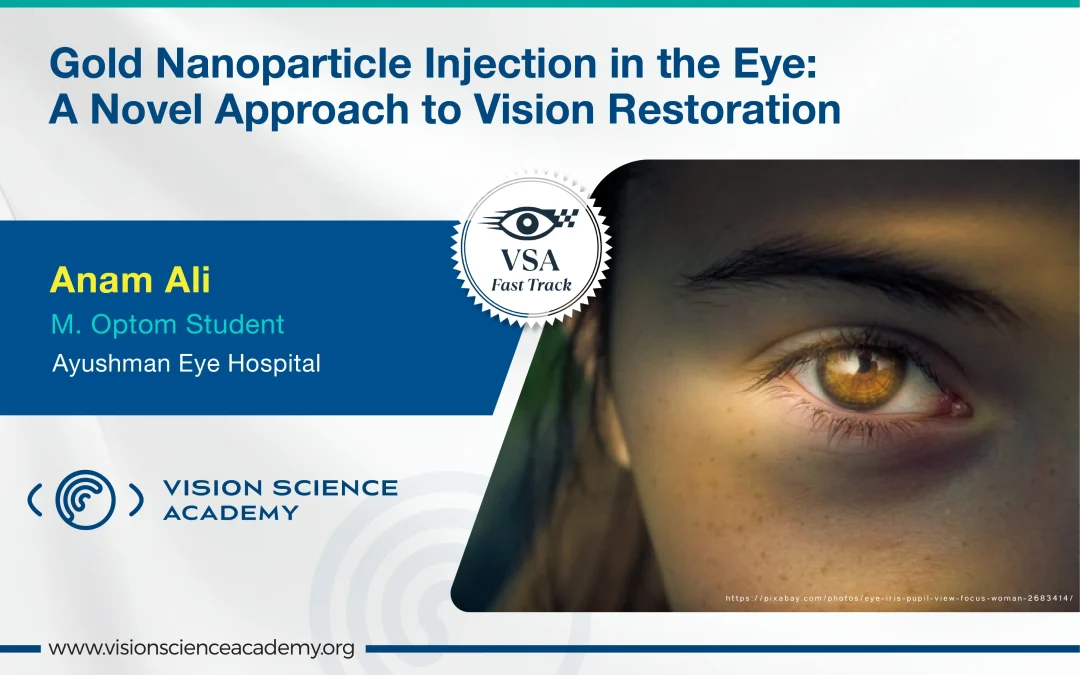Anam Ali, B.Optom.
M. Optom Student, Ayushman Eye Hospital, Bijnor, India
Vision loss from retinal degenerative diseases such as retinitis pigmentosa (RP) and age-related macular degeneration (AMD) is a leading cause of irreversible blindness. These conditions progressively destroy photoreceptor cells in the retina, leading to permanent vision loss. Globally, over 36 million people are blind, and more than 217 million suffer from moderate to severe vision impairment, largely due to retinal disorders. (1)
Traditional treatments only slow down degeneration but do not restore lost vision. However, advances in nanotechnology have introduced a promising alternative: gold nanoparticles (AuNPs). These tiny, light-sensitive particles can potentially restore visual function by acting as artificial photoreceptors. (2)
Mechanism of Action
Gold nanoparticles are biocompatible and photoreactive, meaning they can convert light into electrical signals. When injected into the vitreous cavity or subretinal space, AuNPs bind to the surviving inner retinal neurons, like bipolar and ganglion cells. Upon light exposure, they undergo plasmonic excitation, producing localised electric fields that stimulate these neurons, essentially bypassing the damaged photoreceptors and mimicking natural light processing. (2,3)
A hybrid interface using organic polymers and nanoparticles has also been developed to trigger neuron activation through light, achieving stable visual responses in animal models. (3)
Current Research and Results
Studies have shown that AuNPs can restore light sensitivity in animals with degenerated photoreceptors. (2)
Bio-organic materials have been used to enhance light-controlled stimulation of neurons. (3) Additionally, computational studies on artificial retinas suggest that AuNPs could simplify the design of vision-restoring devices by enabling more direct neural interfacing. (4)
Advantages of Gold Nanoparticles for Vision Restoration
Gold nanoparticles are biocompatible and offer a long-lasting, non-genetic alternative for vision restoration. (2)
Unlike gene therapy or retinal implants, a single injection may restore function with fewer risks and lower costs. (4) This approach shows promise as an accessible treatment for retinal degenerative diseases.
| Aspect | Gold Nanoparticles | Gene therapy | Retinal implants |
|---|---|---|---|
| Mechanism | Artificial photoreceptors stimulate neurons | Alter DNA to produce functional proteins | Electrically stimulate retinal neurons |
| Invasiveness | Minimally invasive injection | Invasive surgical delivery | Highly invasive |
| Longevity of effect | Potential long-term effects with a single injection | Varies, may require repeated treatment | Permanent but prone to hardware failure |
| Biocompatibility | High, chemically inert | Risk of immune response | Risk of tissue damage |
| Stage of development | Experimental, preclinical studies | Some clinical applications | Limited clinical use |
| Cost and Accessibility | Potentially affordable and widely accessible | High cost and technical requirements | High cost and specialized equipment |
Table 1: Comparative analysis of gold nanoparticles- based vision and other treatments. (1-4)
(Self created by author)
Challenges and Limitations
Despite these benefits, this technology is still in the experimental stage. Long-term safety, immune response, control over light sensitivity, and regulatory approval remain major hurdles.
Conclusion
Gold nanoparticle injections could revolutionise the treatment of blindness caused by retinal degeneration. Though early in development, their simplicity, effectiveness, and safety make them a promising alternative to existing methods. With further research and clinical trials, they may lead to a future where vision loss is no longer permanent.
References:
- Bourne RRA, Flaxman SR, Braithwaite T, et al. Magnitude, temporal trends, and projections of the global prevalence of blindness and distance and near vision impairment: a systematic review and meta-analysis. Lancet Glob Health. 2017;5(9):e888-e897. doi:10.1016/S2214-109X(17)30293-0
- Nie T, et al. Golden eyes: How gold nanoparticles may one day help to restore vision. Phys.org. 2025 Apr 16. Available from: https://phys.org/news/2025-04-golden-eyes-gold-nanoparticles-day.html
- Ghezzi D, Antognazza MR, Dal Maschio M, et al. A hybrid bioorganic interface for neuronal photoactivation. Nat Commun. 2011;2:166. doi:10.1038/ncomms1164
- Shah NP, Chichilnisky EJ. Computational challenges and opportunities for a bi-directional artificial retina. J Neural Eng. 2020;17(5):055002. doi:10.1088/1741-2552/aba8b1


Recent Comments